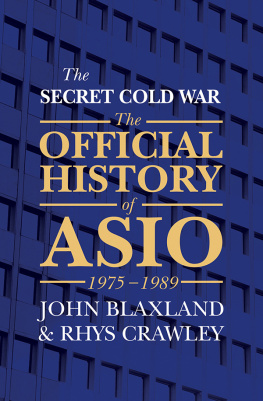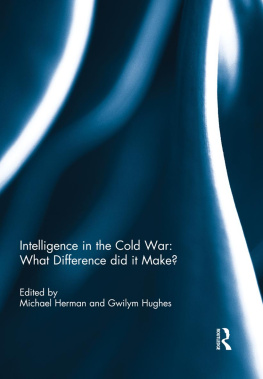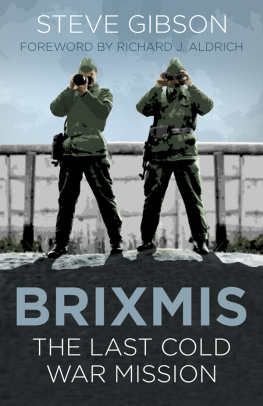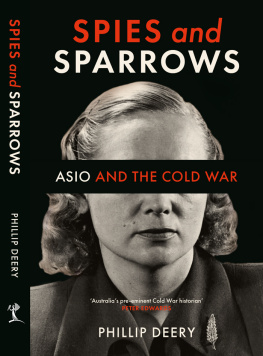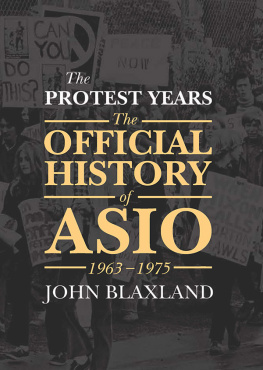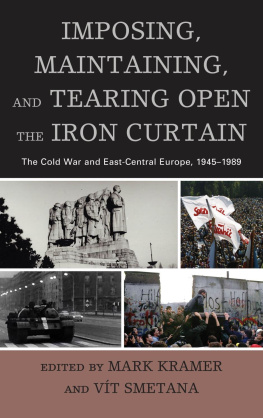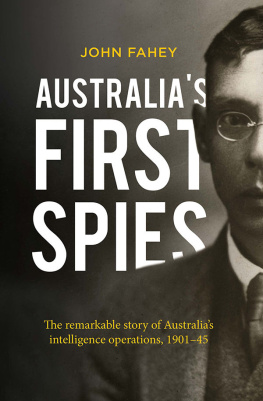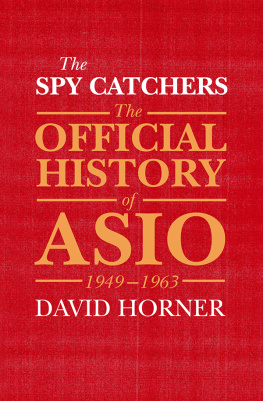THE OFFICIAL HISTORY OF ASIO
General editor: David Horner
The Spy Catchers, Vol. I, by David Horner
The Protest Years, Vol. II, by John Blaxland
The Secret Cold War, Vol. III, by John Blaxland and Rhys Crawley
The Spy Catchers won the Prime Ministers Prize for Australian History and the 2015 St Ermins Hotel Intelligence Book of the Year Award (The St Ermins Hotel in St Jamess Park, London, offers this annual award for the best new intelligence book in recognition of the hotels long connection with the British intelligence community.)
First published in 2016
Copyright The Commonwealth of Australia, as represented by the Australian Security Intelligence Organisation (ASIO) 2016
All rights reserved. No part of this book may be reproduced or transmitted in any form or by any means, electronic or mechanical, including photocopying, recording or by any information storage and retrieval system, without prior permission in writing from the publisher. The Australian Copyright Act 1968 (the Act) allows a maximum of one chapter or 10 per cent of this book, whichever is the greater, to be photocopied by any educational institution for its educational purposes provided that the educational institution (or body that administers it) has given a remuneration notice to the Copyright Agency (Australia) under the Act.
Every effort has been made to trace the holders of copyright material. If you have any information concerning copyright material in this book please contact the publishers at the address below.
Allen & Unwin
83 Alexander Street
Crows Nest NSW 2065
Australia
Phone: (61 2) 8425 0100
Email:
Web: www.allenandunwin.com
Cataloguing-in-Publication details are available
from the National Library of Australia
www.trove.nla.gov.au
ISBN 978 1 76029 321 5
eISBN 978 1 95253 548 2
Index by Garry Cousins
CONTENTS


Figure
Tables

The Secret Cold War is the third volume of the three-volume Official History of the Australian Security Intelligence Organisation (ASIO) and covers the period from 1975 to the end of the Cold War in 1989. The first volume, The Spy Catchers, covering the history of the Organisation from 1949 to 1963, was published in 2014 and the second, The Protest Years, covering the period from 1963 to 1975, in 2015. Since the first volume was published, the series has received strong praise. For example, in 2015 The Spy Catchers was awarded the St Ermins Hotel Intelligence Book of the Year prize and was joint winner of the Australian Prime Ministers Literary Award for History. In view of this success, it might be useful to restate the conditions under which the series was conceived, researched and written.
In 2008 the Commonwealth Attorney-General approved the idea of an official history of ASIO, and the Organisation advertised for authors or institutions to tender to research and write it. Such an official history is not the Organisations view of its history and its assessment of its own achievements or failures. Rather, it is a history of the Organisation, written by an independent historian but based on the Organisations own records. The official history of ASIO is analogous to the official histories of Australias involvement in wars. The official war historians were given full access to government records, but there was no censorship of the histories.
In the tender process, applicants were given an opportunity to present their proposals to ASIO. Several individuals and universities submitted proposals, the Australian National University (ANU) won the tender, and the project began formally in August 2009. ASIO provided funds to ANU, and the project historians were employed by ANU as normal staff members, not by ASIOa common practice for Australian universities that receive funds from outside bodies to undertake specific contracted research.
ASIO did not specially select the authors. As the principal author and official historian, my name was included in ANUs tender response, but after ANU won the tender it advertised for the second author and the research assistant (who later became our third author), and these were selected by ANU. Once the other historians, Dr John Blaxland and Dr Rhys Crawley, had been selected, they then needed to go through the process of being granted appropriate security clearance before they could be given access to highly classified files.
As the principal author, I was adamant about several matters. We would not accept any direction from ASIO as to how we would tell the story, and we would write the history as we saw it, based on ASIOs records. To achieve this aim we would need complete and unrestricted access to all ASIO records relevant to the period we were researching. I am pleased to say that ASIO kept this part of the bargain to the full; it was a courageous and, within the Organisation, controversial decision. Further, because some of the records about ASIO are held by other government departmentssuch as the Attorney-Generals Department and the departments of Defence, Immigration, Foreign Affairs and Trade, and the Prime Minister and CabinetASIO asked those departments for access to relevant records. Those departments generously agreed. Finally, I was adamant that we needed to write the history at ANU. We did not want to become part of ASIO and we needed to keep some academic distance from the Organisation. But obviously, research in ASIOs archives needed to be undertaken on the Organisations premises.
With access to ASIOs record management system, we were able to identify the files we wanted to examine and then request them. We were not denied access to any file that we asked for, no matter how sensitive, and we found files that ASIO did not even know that they had. Not everyone in ASIO agreed that we should have been given these files, and at times the Director-General had to intervene directly to ensure we received them. None of the files we looked at in ASIO were redacted.
The question was not whether we were to be given full access to the records, but whether we would have the capacity (even with the employment of a further research assistant) to identify what we needed from the tens of thousands of files available to us. Whatever the difficulty in selecting the files, our history is based on unredacted records, and our penultimate manuscripts included complete details of operations, techniques and personnel. Our conclusions were therefore based on full accounts of operationsor at least as full as we could make them, noting our resource limitations and the fact that the volumes had to be manageable in terms of length.
Once we had completed the manuscript for each volume, it needed to be cleared by ASIO to ensure it did not disclose techniques that might still be in use, information that had been received from foreign intelligence agencies (and could not be released by ASIO), and the names of ASIO officers and agents. The clearance process involved the authors sitting with ASIO officers and examining each matter ASIO wished to redact. Often ASIO would be satisfied with changing or redacting just one word or phrase. At no stage did ASIO seek to change any of our conclusions. If ASIO thought our conclusions were misguided, we demanded that ASIO show us documents that would prove us wrong. If ASIO could not do so, the manuscript was not changed. Naturally, some aspects of the story we have not been able to publish for reasons of national security or international relations. Not all the names of operations could be released, and in some cases an operational name has been replaced with another name so that the original name is protected.

